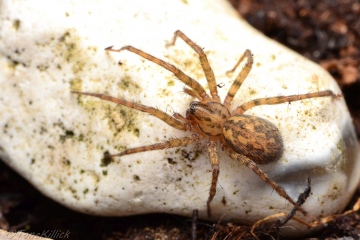Notes on Tegenaria silvestris

On the 19/01/20 I was looking for spiders in a stretch of woodland that has a stream running through it. Habitat was dark and damp. After a while turning over dead wood I came across a Tegenaria silvestris guarding her debris covered egg sac (photo 1) This species is closely related to the common house spider Tegenaria domestica but is generally found in natural habitat i.e woodland.On the same piece of wood was another egg sac and also covered in debris, which is typical of many Agelenids (photo 2) I decided to collect the unguarded egg sac for future observations and placed it in a deli cup. For over two months I kept up observations but with no evidence of activity I began to suspect that it had failed for whatever reason. Then, on the 22/03/20 I looked into the deli cup and was surprised to find a small wasp flying around inside. This gets the grey matter going and first thoughts are, how he hell did that get in there! Then logic kicks in and you start to wonder, have I come across an egg sac that has been parasitized. The next day, I checked on the egg sac and there are now four wasps inside, three live ones and a dead one (video). Now I'm excited, because as much as I'm biased due to my fascination and awe in regards to spiders I have a massively healthy respect for these flying insects that have the balls to to take on top tier invertebrates for the future of their progeny.The following day 24/03/20 I removed the egg sac to photograph but (photo 4) could see no evidence of wasps emerging so decided to open the sac and was confronted by 4 dark coloured egg sacs (photos 5 & 6). It was then a case of collecting the wasps which didn't prove as hard as I anticipated (7 & 8). The wasps were photographed inside a glass vial hence the quality of the images. I then sent my images to Gavin Broad who is the Principal Curator in Charge of Insects at the Natural History Museum and who also specialises in Braconidae, Ichneumonidae taxonomy. He has kindly informed me that the wasp is likely to be Hemiteles species. All I have to do is get these specimens over to him for a definitive identification which bring this little saga to an end!
Added by Tone Killick at 11:38 on Mon 20th Apr 2020. Return to Summary for Tegenaria silvestris